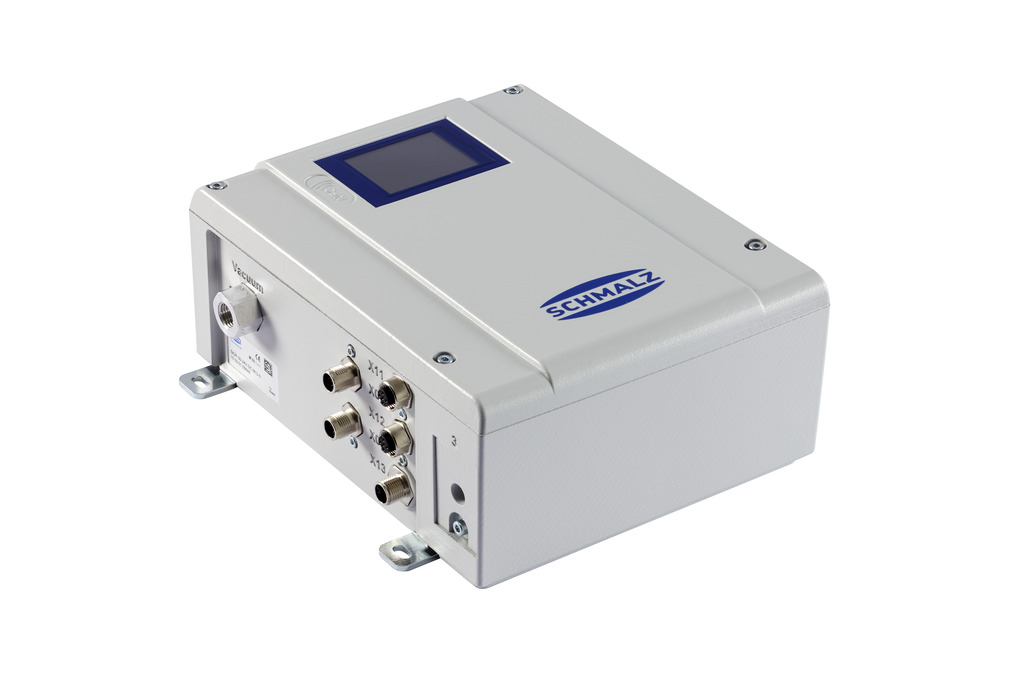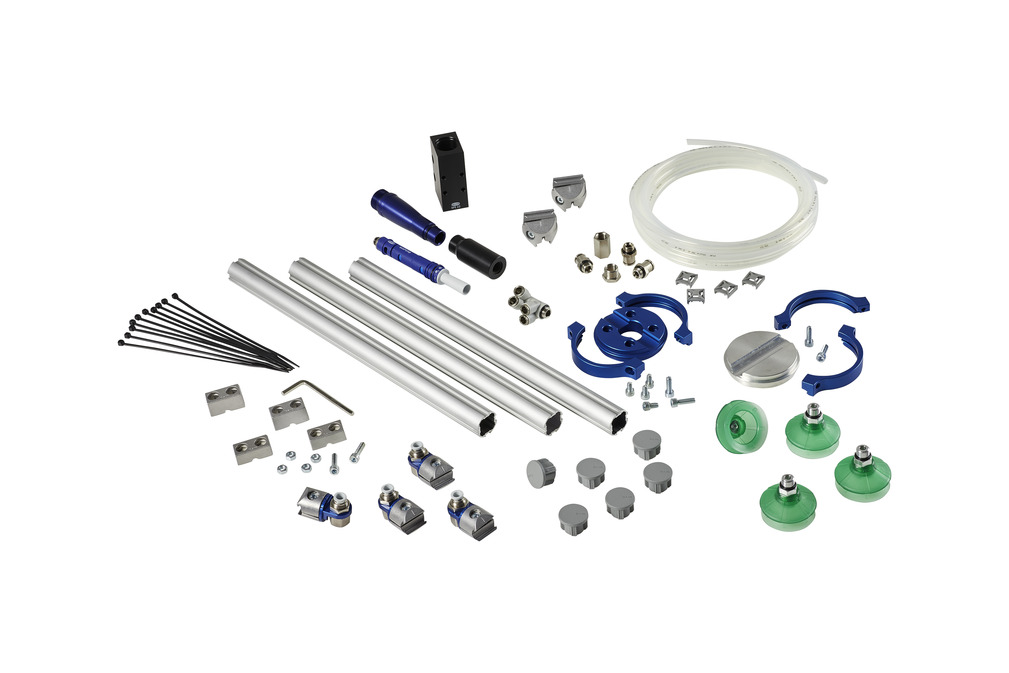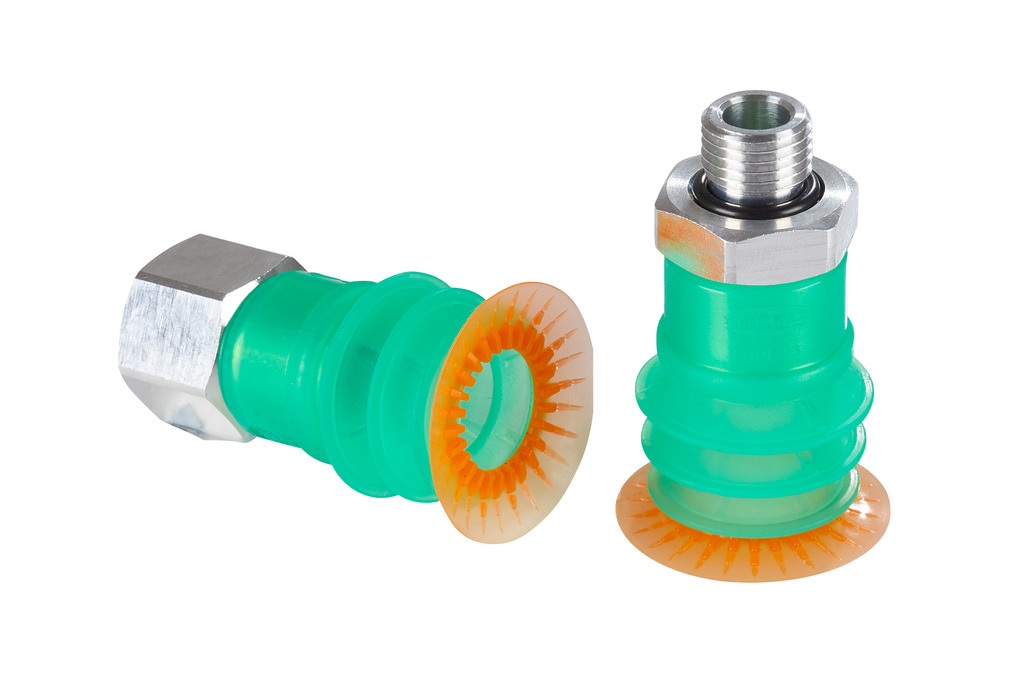Into the crate every five seconds
At the end-of-arm of two cobots, PXT grippers reliably pick up wrapped meat packs.
Wrinkles are sometimes considered a beauty problem. In automated packaging processes, however, they can severely disrupt workflows. This can happen with meat products, for example, which are packaged in plastic trays and sealed with a plastic film. This plastic film is the point of attack for the vacuum suction cups during the subsequent picking process. However, it is deformed by the weight of the packaging and wrinkles. As a result, the wrinkles push conventional gripping solutions to their limits. Despite the soft sealing lips, they do not seal the irregularities adequately and a conventional vacuum generator cannot maintain the vacuum.
IO-Link communication allows us to evaluate all relevant process parameters such as evacuation time and leakage rate. This allows us to detect creeping suction cup wear or leakages in the system.∼ Jan Walter, Head of Sales Germany and Field Service at Schmalz
Bizerba, a specialist in logistics and packaging systems, was therefore looking for a suitable solution to reliably automate the picking of these foil-wrapped trays. The company, headquartered in the Swabian town of Balingen, was founded in 1866 and today produces scales, labeling and marking systems as well as food processing and inspection systems. The global Bizerba team currently consists of 4,500 specialists who are active in 120 countries. The company generates an annual turnover of around 800 million euros.
High pick rate round the clock
A Spanish customer commissioned Bizerba to develop an end-of-line system for the automated picking of meat packaging. Previously, employees stacked the food trays in transport boxes after packaging, weighing and labeling. However, the speed of the manual activity did not meet the requirements and therefore limited the output. Due to the shortage of skilled workers, additional personnel were not available for the meat processor. Automation was therefore required to ensure a higher pick rate and round-the-clock operation.
Together with Kilivations, Bizerba designed a new end-of-line system with two handling robots – the case packer. In Weil im Schönbuch, Kilivations specializes in lean and effective automation solutions that are installed directly on the robot controller. The company integrated the individual components into the automation cell for the meat processor. An important component is two cobots from Universal Robots (UR), which give the grippers the necessary reach. For the end-of-arm effectors, Bizerba and Kilivations rely on the smart and powerful systems from vacuum expert Schmalz.
Process-safe grip
Both identically designed grippers, which are each attached to a cobot arm, use a purely electrical vacuum system from Schmalz. A GCPi type compact pump operates in each of these units, supplying the gripper on the robot arm with vacuum. The compact vacuum generator forms a powerful system with the electrical 3/2-way compact valves LQEi and performs just as well as pneumatic ejector solutions. The GCPi generates the necessary vacuum using an efficient double-head diaphragm pump, which Schmalz has equipped with an integrated energy-saving control system. This controls the speed of the pump as required. Process parameters can be transferred directly via an IO-Link interface.
The two LQEi compact valves, which control two separate suction circuits, are located decentrally on the gripper. They switch the vacuum where it is needed and ensure rapid evacuation and venting of the vacuum system. This significantly speeds up the suction and release times. A sensor integrated in the valve monitors the vacuum and guarantees a high level of process reliability. Thanks to the LQEi's end position fixing and non-return valve, the system maintains the vacuum even in the event of a power failure.
The PXT gripper impresses with its flexibility and modularity. Bizerba and Kilivations put together suitable end effectors from the standard components. If the geometry of the food trays changes later, the components can be recombined. "This is innovative and fits in with our open robot cell, which is only protected by light barriers," emphasizes Oliver Deifel. He is Director Global Customer Solutions & Integration Business at Bizerba. Until now, food processors have relied on closed cells, which were usually only designed for one workpiece format. "The system had to be laboriously converted for changing pack sizes," recalls Deifel.
The PSPF bellows suction cups have direct contact with the meat packaging. Six of them are controlled by an LQEi compact valve. In addition to a flexible and stable bellows, they have a particularly soft sealing lip. This enables the system to handle the film packaging automatically - despite wrinkles. This means that wrinkles become a mere beauty problem. PSPF is made of FDA-compliant silicone and is suitable for contact with food products.
Individual solution
But as is so often the case, the technology is in the detail: with the Compact-Pump GCPi, two separate vacuum circuits per gripper can be implemented via IO-Link. "IO-Link communication allows us to evaluate all relevant process parameters such as evacuation time and leakage rate," explains Jan Walter. He is Head of Sales Germany and Field Service at Schmalz. "This allows us to detect creeping suction cup wear or leakages in the system." This predictive maintenance helps food companies avoid unplanned downtimes.
The entire system is purely electrical, and optimized flow cross-sections and cable lengths enable the gripped workpieces to be deposited quickly and reliably without compressed air. This lowers operating costs. Thanks to the decentralized installation of the LQEi on the gripper, Schmalz achieves extremely fast evacuation and depositing times, which are necessary to achieve the required 96 picks per minute.
A conveyor belt brings the packaged and labeled trays to the pick-up point of Schmalz's handling solution. Each of the two PXT grippers picks up four food packages and places them in the waiting crates – one layer at a time, every five seconds. A roller conveyor then transports these crates to the dispatch area. "It runs like clockwork," says Walter happily.
"The cooperation with Schmalz and Kilivations was consistently positive and together we were able to install an excellent system for our customer in Spain," says Oliver Deifel. "And our client is also very satisfied. He is now running the system with a high throughput, saving on personnel costs and with maximum process reliability thanks to the automation." The case packer has been operating as planned in Spain since the end of 2023, and other customers have already shown interest in the solution. "The smart concept of this system forms the basis for further projects," reveals Deifel.
The automatic gripper solution achieves 96 picks per minute – significantly increasing the meat processor's output compared to manual operations.
The Compact Pump GCPi (top left) provides the required vacuum purely electrically.
The PSPF bellows suction cups pick even irregularly shaped surfaces and deposit them reliably at the target location.
The Compact Pump GCPi has a user-friendly LCD touch display for setting the most important process parameters.
Each of the two grippers picks up four of the pre-packaged and labeled trays and places them in large transport boxes.
Media contact
The Schmalz press team will be happy to answer any questions you may have.



